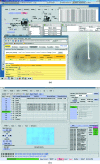Remote access to crystallography beamlines at SSRL: novel tools for training, education and collaboration
- PMID: 22184477
- PMCID: PMC3238386
- DOI: 10.1107/S0021889810024696
Remote access to crystallography beamlines at SSRL: novel tools for training, education and collaboration
Abstract
For the past five years, the Structural Molecular Biology group at the Stanford Synchrotron Radiation Lightsource (SSRL) has provided general users of the facility with fully remote access to the macromolecular crystallography beamlines. This was made possible by implementing fully automated beamlines with a flexible control system and an intuitive user interface, and by the development of the robust and efficient Stanford automated mounting robotic sample-changing system. The ability to control a synchrotron beamline remotely from the comfort of the home laboratory has set a new paradigm for the collection of high-quality X-ray diffraction data and has fostered new collaborative research, whereby a number of remote users from different institutions can be connected at the same time to the SSRL beamlines. The use of remote access has revolutionized the way in which scientists interact with synchrotron beamlines and collect diffraction data, and has also triggered a shift in the way crystallography students are introduced to synchrotron data collection and trained in the best methods for collecting high-quality data. SSRL provides expert crystallographic and engineering staff, state-of-the-art crystallography beamlines, and a number of accessible tools to facilitate data collection and in-house remote training, and encourages the use of these facilities for education, training, outreach and collaborative research.
Figures




Similar articles
-
New paradigm for macromolecular crystallography experiments at SSRL: automated crystal screening and remote data collection.Acta Crystallogr D Biol Crystallogr. 2008 Dec;64(Pt 12):1210-21. doi: 10.1107/S0907444908030564. Epub 2008 Nov 18. Acta Crystallogr D Biol Crystallogr. 2008. PMID: 19018097 Free PMC article.
-
The Stanford Automated Mounter: pushing the limits of sample exchange at the SSRL macromolecular crystallography beamlines.J Appl Crystallogr. 2016 Feb 24;49(Pt 2):622-626. doi: 10.1107/S1600576716000649. eCollection 2016 Apr 1. J Appl Crystallogr. 2016. PMID: 27047309 Free PMC article.
-
The Stanford Automated Mounter: Enabling High-Throughput Protein Crystal Screening at SSRL.JALA Charlottesv Va. 2008 Dec 1;13(6):335-343. doi: 10.1016/j.jala.2008.08.008. JALA Charlottesv Va. 2008. PMID: 19956359 Free PMC article.
-
A comprehensive approach to X-ray crystallography for drug discovery at a synchrotron facility - The example of Diamond Light Source.Drug Discov Today Technol. 2020 Dec;37:83-92. doi: 10.1016/j.ddtec.2020.10.003. Epub 2020 Dec 10. Drug Discov Today Technol. 2020. PMID: 34895658 Review.
-
Automation of macromolecular crystallography beamlines.Prog Biophys Mol Biol. 2005 Oct;89(2):124-52. doi: 10.1016/j.pbiomolbio.2004.09.003. Prog Biophys Mol Biol. 2005. PMID: 15910915 Review.
Cited by
-
Implementation and performance of SIBYLS: a dual endstation small-angle X-ray scattering and macromolecular crystallography beamline at the Advanced Light Source.J Appl Crystallogr. 2013 Feb 1;46(Pt 1):1-13. doi: 10.1107/S0021889812048698. Epub 2013 Jan 17. J Appl Crystallogr. 2013. PMID: 23396808 Free PMC article.
-
New synchrotron powder diffraction facility for long-duration experiments.J Appl Crystallogr. 2017 Feb 1;50(Pt 1):172-183. doi: 10.1107/S1600576716019750. eCollection 2017 Feb 1. J Appl Crystallogr. 2017. PMID: 28190992 Free PMC article.
-
Synchrotron radiation based X-ray techniques for analysis of cathodes in Li rechargeable batteries.RSC Adv. 2022 Jul 13;12(31):20360-20378. doi: 10.1039/d2ra01250b. eCollection 2022 Jul 6. RSC Adv. 2022. PMID: 35919598 Free PMC article. Review.
-
Making sense of SFX data: standards for data and structure validation for a non-standard experiment that has come of age.IUCrJ. 2021 Jun 30;8(Pt 4):482-484. doi: 10.1107/S2052252521006552. eCollection 2021 Jul 1. IUCrJ. 2021. PMID: 34257999 Free PMC article.
-
Synchrotron-based macromolecular crystallography module for an undergraduate biochemistry laboratory course.J Appl Crystallogr. 2016 Nov 24;49(Pt 6):2235-2243. doi: 10.1107/S1600576716016800. eCollection 2016 Dec 1. J Appl Crystallogr. 2016. PMID: 27980518 Free PMC article.
References
Grants and funding
LinkOut - more resources
Full Text Sources
Miscellaneous
